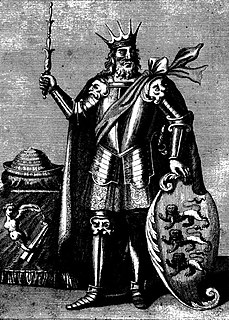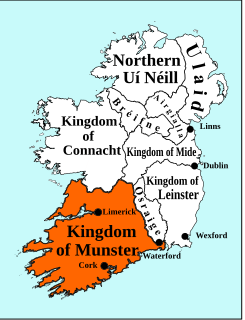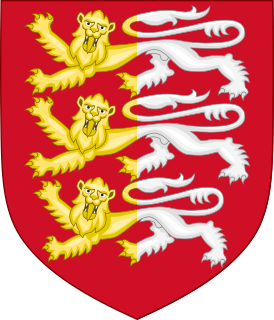
Brian Boru was an Irish king who ended the domination of the High Kingship of Ireland by the Uí Néill. Building on the achievements of his father, Cennétig mac Lorcain, and especially his elder brother, Mathgamain, Brian first made himself King of Munster, then subjugated Leinster, eventually becoming High King of Ireland. He was the founder of the O'Brien dynasty.

The Battle of Clontarf was a battle that took place on 23 April 1014 by the River Tolka, from Clontarf inland, near the then-small Dublin. It pitted forces led by Brian Boru, High King of Ireland, against a Norse-Irish alliance comprising the forces of Sigtrygg Silkbeard, King of Dublin; Máel Mórda mac Murchada, King of Leinster; and an external Viking contingent led by Sigurd, of Orkney; and Brodir of Mann. It lasted from sunrise to sunset, and ended in a rout of the Viking and Leinster forces. It is estimated that between 7,000 and 10,000 men were killed. Although Brian's forces were victorious, Brian himself was killed, as were his son Murchad and his grandson Toirdelbach. Leinster king Máel Mórda and Viking leaders Sigurd and Brodir were also slain.

The Iverni were a people of early Ireland first mentioned in Ptolemy's 2nd century Geography as living in the extreme south-west of the island. He also locates a "city" called Ivernis in their territory, and observes that this settlement has the same name as the island as a whole, Ivernia. The name Iverni has been derived from Proto-Indo-European *PiHwerjoHn, "the fertile land". It was probably once the name given to all the peoples of Ireland, but by Ptolemy's time had a more restricted usage applicable to the inhabitants of the south-west. These Iverni can be identified linguistically with the Érainn, a people attested in Munster and elsewhere in the early Middle Ages.

The Eóganachta or Eoghanachta were an Irish dynasty centred on Cashel which dominated southern Ireland from the 6/7th to the 10th centuries, and following that, in a restricted form, the Kingdom of Desmond, and its offshoot Carbery, to the late 16th century. By tradition the dynasty was founded by Conall Corc but named after his ancestor Éogan, the firstborn son of the semi-mythological 3rd-century king Ailill Aulom. This dynastic clan-name, for it was never in any sense a 'surname,' should more accurately be restricted to those branches of the royal house which descended from Conall Corc, who established Cashel as his royal seat in the late 5th century.
Donnchadh is a Gaelic masculine given name and is common to both the Irish and Scottish Gaelic languages. It is composed of the elements donn, meaning "brown"; and chadh, meaning "chief" or "noble". The name is also written as Donnchad, Donncha, Donnacha, Donnchadha and Dúnchad. In English it is pronounced "Dun-uhh-kah" or "Done + Acka".
The Déisi were a class of peoples in ancient and medieval Ireland. The term is Old Irish, and derives from the word déis, meaning "vassal" or "subject"; in its original sense, it designated groups who were vassals or rent-payers to a landowner. Later, it became a proper name for certain septs and their own subjects throughout Ireland. The various peoples listed under the heading déis shared the same status in Gaelic Ireland, and had little or no actual kinship, though they were often thought of as genetically related. Déisi groups included the Déisi Muman, Déisi Temro, Déisi Becc and the Déisi Tuisceart. During the Early Middle Ages some Déisi groups and subgroups exerted great political influence in various parts of Ireland, and certain written sources suggest a connection to Britain as well. During early medieval Munster, the Déisi were under the hegemony of the Eoganachta confederacy.

The Dalcassians were a Gaelic Irish tribe, generally accepted by contemporary scholarship as being a branch of the Déisi Muman, that became a powerful group in Ireland during the 10th century. Their genealogies claimed descent from Cormac Cas, who is said to have lived in the 3rd century AD. Their known ancestors are the subject of The Expulsion of the Déisi tale and one branch of their blood-line went on to rule the petty kingdom of Dyfed in Wales during the 4th century; probably in alliance with Roman emperor, Magnus Maximus.
Donnchadh Donn mac Flainn was High King of Ireland and King of Mide. He belonged to Clann Cholmáin, a branch of the southern Uí Néill.
Cennétig mac Lorcáin, King of Tuadmumu, died 951. He was the father of Brian Boru.

The Kingdom of Munster was a kingdom of Gaelic Ireland which existed in the south-west of the island from at least the 1st century BC until 1118. According to traditional Irish history found in the Annals of the Four Masters, the kingdom originated as the territory of the Clanna Dedad, an Érainn tribe of Irish Gaels. Some of the early kings were prominent in the Red Branch Cycle such as Cú Roí and Conaire Mór. For a few centuries they were competitors for the High Kingship or Ireland, but ultimately lost out to the Connachta, descendants of Conn Cétchathach. The kingdom had different borders and internal divisions at different times during its history.

Donnchadh mac Briain, son of Brian Bóruma and Gormflaith ingen Murchada, was King of Munster.
Eóganacht Chaisil were a branch of the Eóganachta, the ruling dynasty of Munster during the 5th-10th centuries. They took their name from Cashel which was the capital of the early Catholic kingdom of Munster. They were descended from Óengus mac Nad Froích, the first Christian King of Munster, through his son Feidlimid mac Óengusa.
Events from the 10th century in Ireland.
Deda mac Sin was a prehistoric king of the Érainn of Ireland, possibly of the 1st century BC. Variant forms or spellings include Dedu, Dedad, and Dega. He is the eponymous ancestor of the Clanna Dedad, and may also have been a King of Munster.
Caithréim Chellacháin Chaisil is an Irish pseudo-historical tract from the first part of the 12th century. It is most likely written some time between 1127 and 1134, commissioned by Cormac Mac Carthaigh, king of Munster and claimant to the title High King of Ireland. The tale is ostensibly a biography of Cormac's 10th century ancestor Cellachán Caisil, but in reality a propaganda tract.
Middle Third is a barony in County Tipperary, Ireland. This geographical unit of land is one of 12 baronies in County Tipperary. Its chief town is Cashel. The barony lies between Eliogarty to the north, Iffa and Offa East to the south, Clanwilliam to the west and Slievardagh to the east. It is currently administered by Tipperary County Council.

The O'Brien dynasty is a royal and noble house founded in the 10th century by Brian Boru of the Dál gCais or Dalcassians. After becoming King of Munster, through conquest he established himself as Ard Rí na hÉireann. Brian's descendants thus carried the name Ó Briain, continuing to rule the Kingdom of Munster until the 12th century where their territory had shrunk to the Kingdom of Thomond which they would hold for just under five centuries.








